
A bathroom or washroom is a room, typically in a home or other residential building, that contains either a bathtub or a shower. The inclusion of a wash basin is common. In some parts of the world e.g. India, a toilet is typically included in the bathroom; in others, the toilet is typically given a dedicated room separate from the one allocated for personal hygiene activities. In North American English the word 'bathroom' is sometimes used to refer to any room in a residence that contains a toilet, regardless of the inclusion of a bath or shower.
Formia is a city and comune in the province of Latina, on the Mediterranean coast of Lazio, Italy. It is located halfway between Rome and Naples, and lies on the Roman-era Appian Way. It has a population of 38,095.

Itri is a small city and comune the province of Latina, Lazio, central Italy.

Fondi is a city and comune in the province of Latina, Lazio, central Italy, halfway between Rome and Naples. As of 2017, the city had a population of 39,800. The city has experienced steady population growth since the early 2000s, though this has slowed in recent years.

A spa is a location where mineral-rich spring water is used to give medicinal baths. Spa towns or spa resorts typically offer various health treatments, which are also known as balneotherapy. The belief in the curative powers of mineral waters goes back to prehistoric times. Such practices have been popular worldwide, but are especially widespread in Europe and Japan. Day spas and medspas are also quite popular, and offer various personal care treatments.
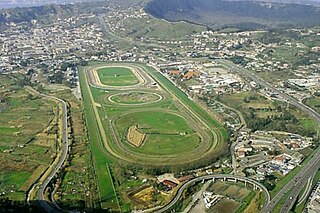
Agnano is a suburb of Napoli, Italy, situated southwest of the city in the Campi Flegrei region. It was popular among both ancient Greeks and Romans and was famed for its hot sulphurous springs.
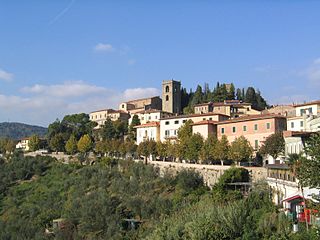
Montecatini Terme is an Italian municipality (comune) of c. 20,000 inhabitants in the province of Pistoia, Tuscany, central Italy. It is the most important center in Valdinievole. The town is located at the eastern end of Piana di Lucca and has a strong tourism industry, as well as industrial and commercial industries related to the spa, which in turn has increased the interest for hotel accommodation in the region.
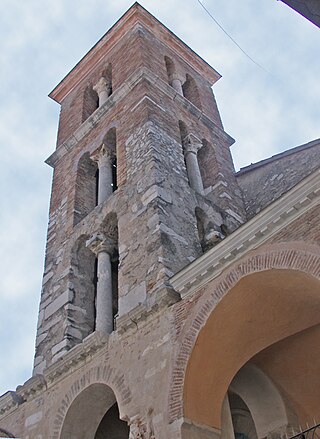
Minturno is a city and comune in southern Lazio, Italy, situated on the north west bank of the Garigliano.

Sessa Aurunca is a town and comune in the province of Caserta, Campania, southern Italy. It is located on the south west slope of the extinct volcano of Roccamonfina, 40 kilometres (25 mi) by rail west north west of Caserta and 30 kilometres (19 mi) east of Formia.
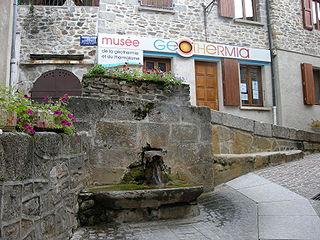
Chaudes-Aigues is a commune in the Cantal department in south-central France. It is a spa town, famous for its hot spring waters.

Latium adiectum or Latium Novum was a region of Roman Italy between Monte Circeo and the river Garigliano, south of and immediately adjacent to Old Latium, hence its name of attached Latium.

Acquasparta is a town and comune in the province of Terni. It is located on a hill above the Naia Valley and the river of the same name, facing the Monti Martani mountain range.
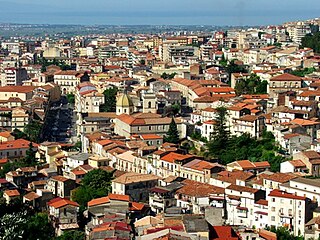
Lamezia Terme, commonly called Lamezia, is an Italian city and comune of 70,452 inhabitants (2013), in the province of Catanzaro in the Calabria region.

Castelforte is a town and comune in the province of Latina, in the Lazio region of central Italy. It is located at the feet of the Monti Aurunci massif.

Campolattaro is a comune (municipality) of 995 inhabitants in the Province of Benevento in the Italian region of Campania, located about 60 kilometres (37 mi) northeast of Naples and about 20 kilometers north of Benevento, its provincial capital. Bordering the municipalities of Casalduni, Circello, Fragneto l'Abate, Fragneto Monforte, Morcone, and Pontelandolfo, Campolattaro is part of the historic region of Samnium.

The Monti Aurunci is a mountain range of southern Lazio, in central Italy. It is part of the Antiappennini, a group running from the Apennines chain to the Tyrrhenian Sea, where it forms the promontory of Gaeta. It is bounded to the north-west by the Ausoni Mountains, to the north by the Liri river, to the east by the Ausente, to the south-east by the Garigliano and to the south by the Tyrrhenian sea. The line between the Aurunci and the Ausoni has not been clearly established but the Aurunci are considered by convention to be east of a line through Fondi, Lenola, Pico, S. Giovanni and Incarico. Altitudes vary from hills to the 1,533 m of Monte Petrella. Main peaks include the Redentore (1,252 m) and Monte Sant'Angelo (1,402 m). They include a regional park, the Parco Naturale dei Monti Aurunci, created in 1997.

There is a long history of tourism in Hungary, and Hungary was the world's thirteenth most visited tourist destination country in 2002. Tourism increased by nearly 7 percent between 2004 and 2005. European visitors comprise more than 98 per cent of Hungary's tourists. Austria, Germany, and Slovakia make the largest numbers of visitors to the country. Most tourists arrive by car and stay for a short period of time. Hungary's tourist season is from April through October. July and August are the best tourist months. Budapest is the country's most popular tourist destination.
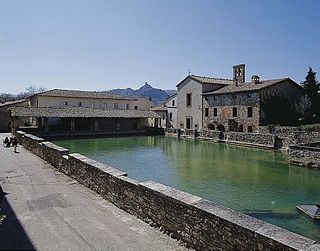
Bagno Vignoni is an Italian village and hamlet (frazione) of San Quirico d'Orcia, situated on a hill above the Val d'Orcia in Tuscany. It is a popular tourist destination and well known for its hot springs.

The Volcano of Roccamonfina is an extinct volcano in Roccamonfina, Campania, southern Italy. It was active from some 650,000 to 50,000 years ago. It comprises an isolated large cone of some 25 km (16 mi) perimeter between the Monti Aurunci, the plain and valley of the Garigliano, the Monte Massico and the Monti Trebulani. The central caldera has a diameter of nearly 6 km (4 mi) and the small commune (town) of Roccamonfina is located inside it. Volcanic activity is now replaced by minor seismic movements and by the presence of mineral waters. The mount is part of the Roccamonfina-Garigliano Mouth Regional Park, created in 1999.

Terme Taurine, also known as the Taurine Baths, is a large elaborate ancient Roman baths complex located about 4 km east of the city of Civitavecchia. The baths were known as the Taurine Baths in reference to the nearby Ancient Roman village of Aquae Tauri.




















